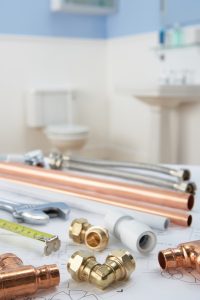 In the first half of the 20th century, and in fact all the way up through the 1970s, the most common type of material used in fresh water pipes for homes and businesses was galvanized steel, lead, cast iron, and even clay. But the cost of these materials, the ease with which they broke and corroded over time, as well as the dangers they posed from allowing toxicity into drinking water, led to them being replaced with new materials by the 1980s: principally copper and various types of plastic such as PEX, PVC, and CPVC. These newer piping materials reduce costs, benefit the environment, last longer, and help keep drinking water safe for households.
In the first half of the 20th century, and in fact all the way up through the 1970s, the most common type of material used in fresh water pipes for homes and businesses was galvanized steel, lead, cast iron, and even clay. But the cost of these materials, the ease with which they broke and corroded over time, as well as the dangers they posed from allowing toxicity into drinking water, led to them being replaced with new materials by the 1980s: principally copper and various types of plastic such as PEX, PVC, and CPVC. These newer piping materials reduce costs, benefit the environment, last longer, and help keep drinking water safe for households.
When you call on our plumbers to replace pipes or to handle more extensive repiping services in Winter Springs, FL, they will use a variety of different materials to see that the best job gets done. And the two materials we favor the most are copper and CPVC (chlorinated polyvinyl chloride).
So why are these two the piping materials of choice? Let’s take a closer look.
A Few of the Advantages of Copper and CPVC Piping
- Copper and CPVC are mostly non-toxic materials. High toxicity levels are one of the reasons that lead pipes were phased out (and still need to be replaced in many places). Copper is non-permeable so it won’t absorb other contaminants that can enter drinking water.
- Corrosion is one of the main enemies of plumbing systems, but copper and CPVC piping are corrosion resistant. They aren’t corrosion proof, however, but the more common forms of corrosion that eventually gnaw away at other types of pipes won’t shorten the life of copper or CPVC pipes. You can expect many years of service with few leaks thanks to modern piping material.
- Both materials are easier to work with for plumbers, cutting down on time and labor expenses. For one thing, they are lightweight. For another, they’re more malleable. Even rigid copper, which is the kind most commonly used for fresh water pipes, is much easier to shape and form into tight positions compared to other types of metals. It’s also possible to eliminate elbows and joints, which further helps reduce the cost of installations.
- Copper and particularly CPVC are less expensive materials in general.
- Because copper and CPVC are made from recyclable materials, they have a lower negative impact on the environment. The majority of copper is also domestically produced and is abundantly found across the country.
- Copper pipes are better at handling temperature swings and high heat, which further contributes to their long lifespan.
If you live in an older home (pre-1970) that doesn’t use copper or plastic pipes, we strongly advise you call up our plumbers to see about the possibility of partial or whole-house repiping. This is especially important if your home may still have lead pipes (built pre-WWII), since lead poisoning is one of the lead water quality dangers remaining in homes. If you require water treatment assistance along with your repiping, we’re also qualified to test your water and install water treatment systems.
Modern Plumbing Industries, Inc.: Proudly Serving Central Florida Since 1975.
